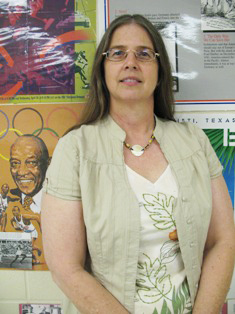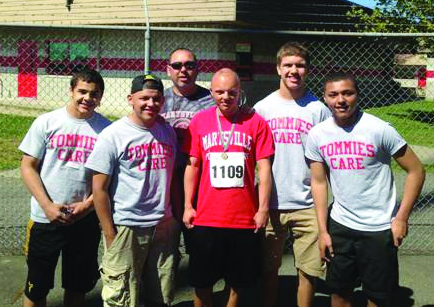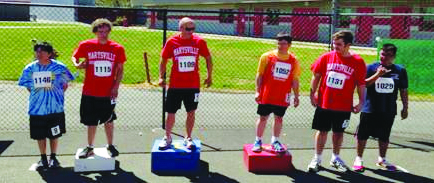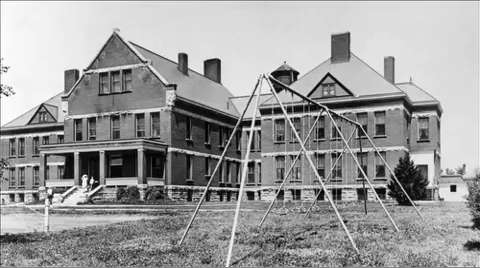By Gene Lehmann, Chickasaw Nation Media
 “If you can read this, thank a teacher,” the bumper sticker ahead stated triumphantly.
“If you can read this, thank a teacher,” the bumper sticker ahead stated triumphantly.
It takes passion to be a teacher. It takes devotion. It requires patience and it requires an understanding some students are going to excel in a vocational setting while others will earn doctorates. It is why this Sunday, America observed National Teacher’s day.
Chickasaw Ellen Brooker has seen all of this in 28 years of teaching and within her own family. She accepts it and celebrates it.
Bill Anoatubby said that Ellen Brooker is a great example of what a teacher should be.
“Ellen Brooker epitomizes the best attributes of a true educator, said Gov. Anoatubby. She does more than help students learn the subject matter, she inspires them to see every situation as an opportunity to learn and grow as an individual. She helps her students understand the importance of lifelong learning.”
The 2012 Chickasaw Nation Dynamic Woman of the Year recently came across a saying she loves: “Those who can — teach. Those who can’t — legislate. It just seems to reflect the issues that keep coming up in Texas education –my favorite saying when it comes to education is “All students can learn,” she said.
“We all have perceptions about what is fair and right and just. What we are envisioning is a perfect world and we don’t live in a perfect world,” Brooker said. At Southwest High School in San Antonio, Brooker has taught for 26 years of her career. Her enthusiasm for teaching and for her students grows exponentially each year.
“I am passionate about teaching history; passionate about American history and economics,” she said. For Brooker, history is more than remembering a smattering of important dates. It’s about equipping students to perform the task of critical thinking; of doing their own research and evaluating the problems and solutions to reach their own conclusions.
“The teacher who instructs critical thinking will give students the skills to be successful,” she states.
She challenges her students to not accept the norms of her parents, siblings, friends and associates. She expects them to research, discover, read, watch and determine for themselves what to believe and what to reject.
“I love my parents very much but my mother is a strong southern Democrat who votes a straight party ticket, and my dad is tea party,” Brooker said. “Consequently, we don’t visit about politics very much,” she explains with a hearty laugh.
What’s the best part about being a teacher? “Being there when the light bulb comes on and they get it, understand it and are excited about what they have just discovered,” she said.
What’s the worst part: “Some students just do not see the opportunities of education or how it will translate to a better life for them. They don’t work hard enough to learn and they miss opportunities that could have been available to them.”
Brooker is educated to the highest order.
Brooker has been an Outstanding American Teacher award recipient, winning grant writer, department chair and respected history and social studies teacher.
She has a master’s degree in Education with a specialization in instructional technology from Houston Baptist University and is certified in history and government, gifted and talented.
Brooker was recently chosen as a participant in the Library of Congress Teaching with Primary Sources Summer Teacher Institute and helped her department win gold performance awards for social studies.
An avid student of Chickasaw language and culture herself, Brooker incorporates traditional regalia and Chickasaw phrases in her classroom. She offers a unique study of Native culture, artifacts and storytelling in American Indian history. Brooker is the vice chair of the Chickasaw Community Council of South Texas where she assists Native American students and other community members in establishing tribal affiliation, learning about tradition, seeking benefits for higher education. Brooker promotes Chickasaw culture, tribal involvement and activities and fundraising to provide college scholarships.
She celebrates the diversity of education – even within her own family.
“My husband, Daniel, and oldest son, Shawn, tried college but decided that it wasn’t what they were necessarily looking for. Not everyone is suited for college. There are students who will excel at mechanics or welding because that is where their interests and passions are. My other son, Michael, is a computer geek – and doesn’t mind being called a geek. He will earn a degree in Internet security systems,” said Brooker as a way of illustrating education appeals to many different types of people with diverse interests and backgrounds.













